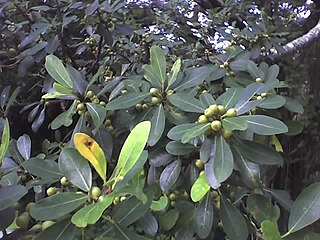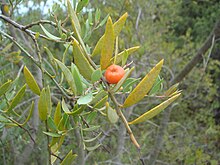
Lactuca, commonly known as lettuce, is a genus of flowering plants in the family Asteraceae. The genus includes at least 50 species, distributed worldwide, but mainly in temperate Eurasia.

Terminalia is a genus of large trees of the flowering plant family Combretaceae, comprising nearly 300 species distributed in tropical regions of the world. The genus name derives from the Latin word terminus, referring to the fact that the leaves appear at the very tips of the shoots.
Cephalocroton is a genus of plant of the family Euphorbiaceae first described as a genus in 1841. It is native to central, eastern, and southern Africa from Nigeria and Ethiopia south to KwaZulu-Natal.

Sclerocroton is a plant genus of the family Euphorbiaceae first described as a genus in 1845. There a total of 6 known species in this genus; 5 species in continental Africa and a single species in Madagascar.
- Sclerocroton carterianus(J.Léonard) Kruijt & Roebers - Liberia, Ivory Coast, Sierra Leone
- Sclerocroton cornutus(Pax) Kruijt & Roebers - C + SC Africa from Cameroon to Zimbabwe plus Ivory Coast
- Sclerocroton integerrimusHochst. - C + S Africa from Zaire to KawZulu-Natal, plus Guinea
- Sclerocroton melanostictus(Baill.) Kruijt & Roebers - Madagascar
- Sclerocroton oblongifolius(Müll.Arg.) Kruijt & Roebers - Zaire, Angola, Zambia, Zimbabwe
- Sclerocroton schmitzii(J.Léonard) Kruijt & Roebers - Zaire, Rwanda, Burundi, Zambia, Zimbabwe

Diospyros mespiliformis, the jackalberry, is a large dioecious evergreen tree found mostly in the savannas of Africa. Jackals are fond of the fruit, hence the common names. It is a member of the family Ebenaceae, and is related to the true ebony and edible persimmon.

Juniperus procera is a coniferous tree native to mountainous areas in Africa and the Arabian Peninsula. It is a characteristic tree of the Afromontane flora.

Helictotrichon, or alpine oatgrass, is a genus of perennial flowering plants in the grass family. The genus name comes from the Greek heliktos meaning twisted, and trichos meaning hair, referring to the shape of the awn.
Dypsis lanceolata is a species of flowering plant in the family Arecaceae. It is found only in Comoros.

Rhamnus × intermedia is a hybrid species of plant in the family Rhamnaceae. It is a hybrid between Rhamnus orbiculata and Rhamnus saxatilis. It is found in Albania, Bosnia and Herzegovina, and Croatia.

Melaleuca lanceolata commonly known as black paperbark, moonah, Rottnest Island teatree and western black tea tree is a plant in the myrtle family, Myrtaceae and is native to Australia where it occurs in Western Australia, South Australia, Victoria, New South Wales and Queensland. It is a densely foliaged tree with rough bark, which flowers prolifically in summer.

Ficus natalensis is a tree in the family Moraceae. It is commonly known as the natal fig in South Africa. In central and western Uganda, where it has an important cultural value, it is known as omutuba to the Baganda people and omutoma to the Banyakitara peoples. In English is sometimes referred as barkcloth fig. It is commonly mistaken for its cousin the Ficus thonningii also known as mugumo to the Agikuyu. These trees are distributed from north-eastern South Africa to Uganda and Kenya.

Bridelia micrantha, the mitzeeri or the coastal golden-leaf, is a tree in the family Phyllanthaceae and is native to tropical and southern Africa as well as to the island of Réunion in the Indian Ocean.

Steganotaenia araliacea is a species of flowering plant in the family Apiaceae. It is found in Angola, Benin, Botswana, Cameroon, Democratic Republic of Congo, Ethiopia, Kenya, Mozambique, Namibia, Somalia, South Africa, Sudan, Tanzania, Togo, Uganda, Zambia, Zimbabwe.

Acokanthera oblongifolia is a plant in the family Apocynaceae. It grows as an evergreen shrub or small tree up to 6 metres (20 ft) tall. Its fragrant flowers feature a white tinged pink corolla. The berries are purple when ripe. Its habitat is dry forest and coastal thickets. Acokanthera oblongifolia is used in local African medicinal treatments for snakebites, itches and internal worms. The plant has been used as arrow poison. The species is native to Mozambique and South Africa.

Diplorhynchus is a monotypic genus of plant in the family Apocynaceae native to tropical and southern Africa. As of August 2020, Plants of the World Online recognises the single species Diplorhynchus condylocarpon.
Pleiocarpa pycnantha is a plant in the family Apocynaceae.

Donella lanceolata is a plant species in the family Sapotaceae. It is a tree growing up to 30 metres (100 ft) tall, with a trunk diameter of up to 40 cm (16 in). The bark is grey to dark brown. Inflorescences bear up to 45 flowers. The fruit are brownish to purplish black, ripening yellow, round, up to 4 cm (2 in) in diameter. Its habitat is lowland forests from sea level to 700 metres (2,300 ft) altitude. Its natural range is Madagascar, India, Sri Lanka, Thailand, Cambodia, Laos, Vietnam, Malaysia, Brunei, Indonesia, the Philippines, Papua New Guinea, the Solomon Islands and Queensland.

Digitalis nervosa is a species of flowering plant in family Plantaginaceae. It is native to the Caucasus down to north western and northern Iran.

Girardinia is a genus of flowering plants belonging to the family Urticaceae.
Schimpera is a monotypic genus of flowering plants belonging to the family Brassicaceae. The only species is Schimpera arabica.

















